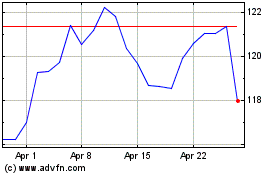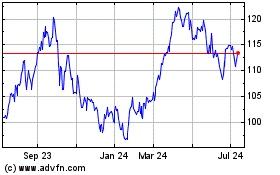Exxon Loses Its Triple-A Rating -- WSJ
April 27 2016 - 3:03AM
Dow Jones News
By Erin Ailworth and Austen Hufford
Exxon Mobil Corp. was stripped Tuesday of the perfect triple-A
credit rating it has held for more than six decades by Standard
& Poor's Ratings Services, a sign that the oil bust is hurting
even the strongest players in the energy industry.
The world's largest publicly traded oil company, Exxon, was just
one of three American companies -- Microsoft Corp. and Johnson
& Johnson are the others -- that had the triple-A rating.
S&P said it first gave the company the triple-A mark in 1949. A
representative for Exxon said it had been triple-A since 1930,
counting its predecessor companies.
But the company's willingness to go into debt to fund its
capital spending and keep paying out dividends even as oil prices
plunged from highs of over $100 a barrel to as low as $26 has taken
a toll on its balance sheet. Its total debt, which stood at $38.7
billion at the end of last year, has more than tripled since 2012,
according to S&P Global Market Intelligence.
"Nothing has changed in terms of the company's financial
philosophy or prudent management of its balance sheet," Exxon
spokesman Scott Silvestri said Tuesday.
In downgrading Exxon by one notch to double-A-plus, S&P
cited the company's rising debt level and said dividend payments
and share repurchases "substantially exceeded" internally generated
cash flow.
U.S. government debt itself is ranked at double-A-plus.
Earlier this year, Exxon sold $12 billion of new bonds in one of
the biggest corporate-debt deals of the year. S&P said it
expects Exxon to return cash to shareholders instead of reducing
its debt.
"Other AAAs have no debt or almost no debt and a lot of cash,"
said Ben Tsocanos, an analyst for the ratings agency, in a February
interview. "Exxon is the only AAA company in a capital intensive
industry. That should be kept in mind."
The ratings downgrade isn't expected to affect Exxon's ability
to borrow money. But the triple-A rating status -- which Exxon
managed to maintain in one form or another through the Great
Depression, World War II, Arab oil embargo and several previous
price crashes -- had long been a point of pride for the Irving,
Texas company.
Exxon Chief Executive Rex Tillerson said during an interview
with CNBC in March that he'd be disappointed if it lost the
triple-A rating. "You know, over 90 years of being AAA, this is not
the first time we've been through a period of this pretty extreme
stress on the financial-model of the company," he said. "I hope we
can maintain the rating 'cause it's important to us
reputationally."
Investors rely on ratings from S&P, Moody's Investors
Service and Fitch Ratings when deciding whether to buy bonds.
In February, S&P cut the ratings of 10 U.S. oil and gas
exploration and production companies, citing the price decline. It
also placed Exxon on watch for a possible downgrade, which was
resolved with Tuesday's release. S&P said Exxon's outlook is
stable.
Also in February, Moody's Investors Service affirmed its
triple-A rating for Exxon but placed the company on a negative
outlook, saying it feared a diminished level of capital
reinvestment could hurt Exxon's ability to replace reserves and
hurt production in future years. It stood by that rating and
outlook in an April 1 credit opinion.
Peter Speer, an analyst with Moody's, said Exxon's problem is
that it is completing complex, large-scale, expensive projects that
don't work in the current low-price environment.
"There will be higher prices in the future, but not returning
anywhere to the prices we saw a few years ago," Mr. Speer said.
Energy companies have suffered from a prolonged decline in oil
and natural gas prices, with many severely cutting planned capital
expenditures.
The financial ratings industry has been under criticism in
recent years stemming from the high-marks given to mortgage-backed
securities, whose failure later caused the financial crisis. In
Feb. 2015, S&P agreed to pay $1.5 billion to resolve litigation
alleging it knowingly issued rosy grades of risky mortgage bonds
before the crisis.
--Bradley Olson contributed to this article.
Write to Erin Ailworth at Erin.Ailworth@wsj.com and Austen
Hufford at austen.hufford@wsj.com
(END) Dow Jones Newswires
April 27, 2016 02:48 ET (06:48 GMT)
Copyright (c) 2016 Dow Jones & Company, Inc.
Exxon Mobil (NYSE:XOM)
Historical Stock Chart
From Mar 2024 to Apr 2024

Exxon Mobil (NYSE:XOM)
Historical Stock Chart
From Apr 2023 to Apr 2024
